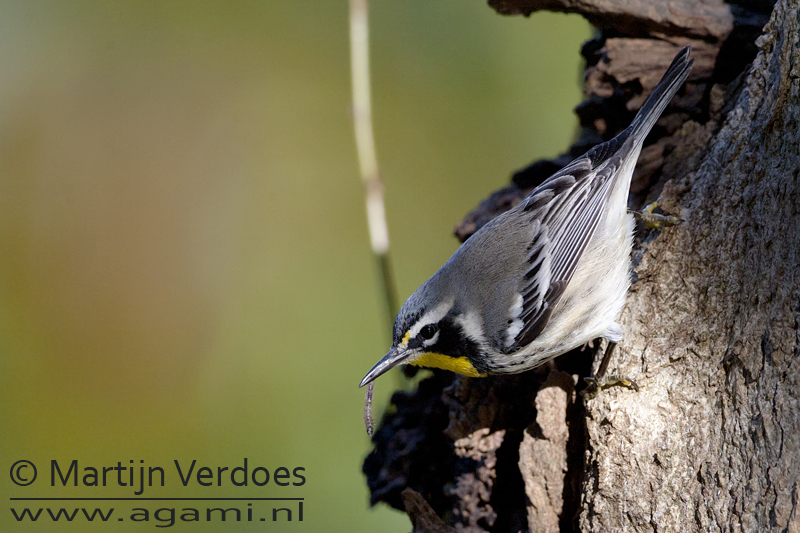Yellow-throated Warbler (Setophaga dominica)
Sue Bierman/Ferry Park, San Francisco, San Francisco County, CA
27 November 2011
Joseph Morlan
Photo © 26 November by Martijn Verdoes/www.agami.nl Used by permission. All rights reserved.

After learning that Martijn Verdoes had seen and photographed the Yellow-throated Warbler at Sue Bierman/Ferry
Park yesterday (see image to the left), I decided to try for the second time to see this bird which appears to
be attempting to winter in the area. It has been frequenting the tall Lombardy Poplar (Populus nigra 'Italica')
trees.
We arrived around 10:30 AM and met Laurie Graham and Jeff Fairclough who said they had just seen both the Lucy's
Warbler (found 13 November by Mark Rauzon) and the continuing Yellow-throated Warbler. After about 10 minutes,
Laurie spotted the Yellow-throated Warbler and we got good looks at the bird as it foraged in curled up dead leaves
in the row of Poplars directly behind the maintenance building. It was mostly fairly low and in good light. It
was more lethargic than the numerous Townsend's and Yellow-rumped warblers and had the knack of disappearing into
the middle of dense leaf clusters.
Laurie then spotted the Lucy's Warbler just as Ginny Marshall and Anne Kelley arrived and we all got good views
of the Lucy's Warbler. At least one Black-throated Gray Warbler was also in the flock.
Description
The following description is based on memory and on photos:
A medium-sized warbler about the same size as the nearby Townsend's Warblers, but with a longer and thinner
looking bill.
The face was marked with a bold dark wedge-shaped ear patch which was separated from the back and scapulars
by a white spot, and from the eye by a white sub-ocular crescent. The black connected to the dark eye on either
side forming an eyeline which connected to the back, but which was separated from the crown by a bold white supercilium.
The supraloral area had a yellow spot, but the yellow did not extend all the way to the base of the bill. The crown
and back were gray, with a slight bluish tint to the cap which was outlined by black spotting forming a "V"
which separated the crown from the forward part of the supercilium.
The rest of the back was plain gray with a slight brownish tinge. In the field the back appeared to be completely
unmarked. The throat was a solid bright yellow color, framed laterally by the black face patch but connecting to
the white of the underparts at the bottom. The sides of the breast had narrow black streaks while the flanks had
only a couple broad, blurry streaks. The flanks were otherwise tinged with dull buff (not visible in the photo
above, but evident in other photos and in the field). The wings were dark with white tips to the greater and median
coverts, forming two distinct wing-bars. The remiges were dark but conspicuously edged in white. The dark tail
was likewise edged white with long white spots on the inner webs that extended to the top of the underside of the
tail; a tail pattern similar to Townsend's Warbler. The feet and legs were dark.
I listened for chip notes, but did not hear it call. This individual has apparently been generally silent
during its stay thus far.
Discussion
This bird was first discovered at Ferry Park 13 September 2011 by Jack Hayden and it has been seen by numerous
observers and well photographed. Here are some outside links to additional photos:
It is customary to separate this species into subspecies groups, a white-lored group S. d. albilora and
a yellow-lored group composed of two races S. d. dominica and S. d. stoddardi. Most California records
have been referable to S. d. albilora but a few late fall and winter records have been assigned to nominate
dominica, although some of those are controversial.
This bird shows a mixture of yellow and white in the lores, and photos show the chin to be white which is typical
of albilora. The bill appears to be very long and thin which is better for dominica, but there is
overlap in all these characters. McKay (2008) found that none of the three traditional subspecies were significant
evolutionary units nor could they be reliably diagnosed on morphology. He recommend eliminating the subspecies
S. d. albilora and S. d. stoddardi because they cannot be reliably diagnosed by morphology or mtDNA.
It is also difficult to determine age and sex in this species. The brownish tinge to the back suggests the bird
is an immature and the indistinct flank streaking with buffy wash on the flanks suggests it may be a female.
This species was formerly included in the genus Dendroica. It was merged with Setophaga in the
52nd Supplement to the AOU Checklist. (The Auk 128:600-613, 2011). [PDF]
There are currently 132 accepted records of this species in California, 45 of those occurred during the 10 year
period, 2000-2010. This species is no longer within guidelines (average of four or fewer records per year for ten
years) for California Bird Records Committee review and should probably be removed from the committee's review
list.
Reference
McKay, B. 2008. Phenotypic variation is clinal in the Yellow-throated Warbler. Condor 110:569-574. [PDF]
